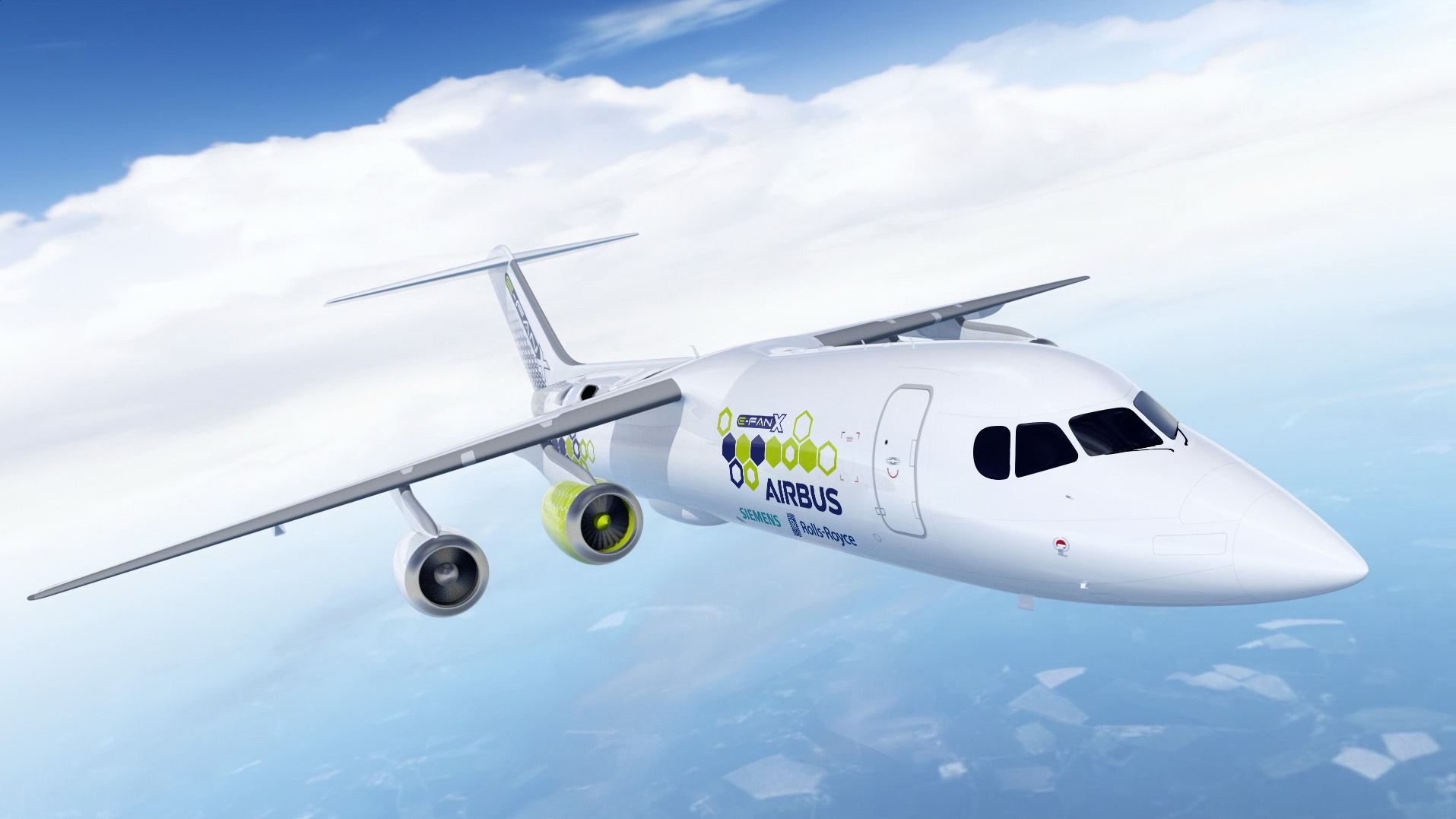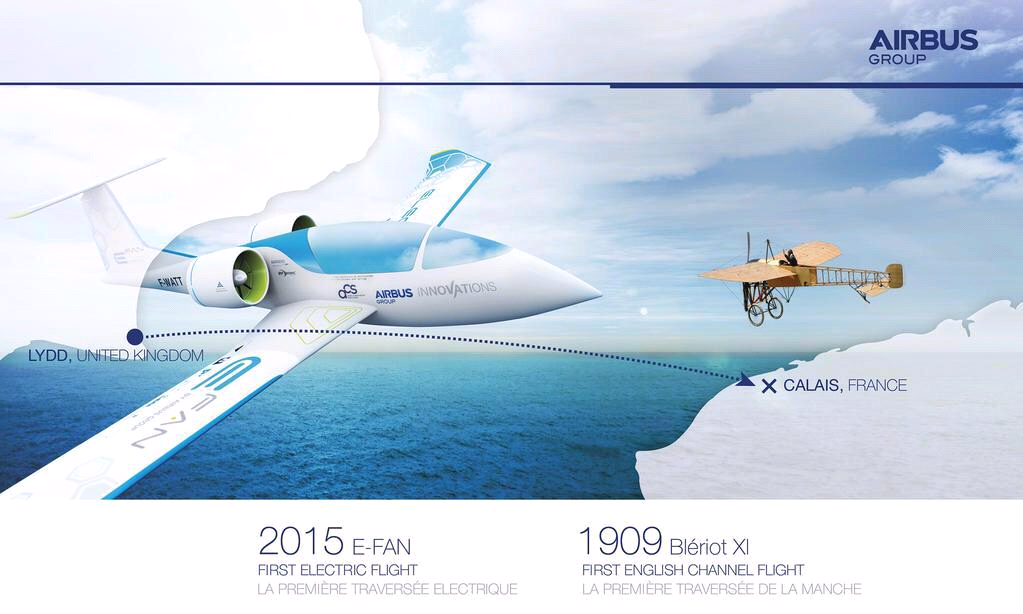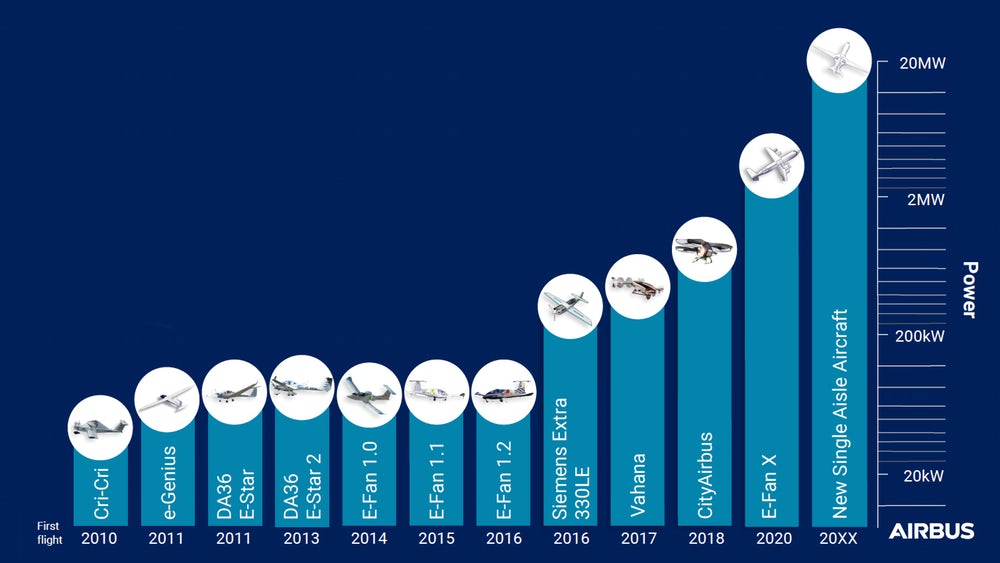Leeham News and Analysis
There's more to real news than a news release.
Airbus, Rolls-Royce and Siemens develops Hybrid-Electric demonstrator
By Bjorn Fehrm
November 29, 2017, © Leeham Co.: Airbus, Rolls-Royce and Siemens yesterday announced they will fly a hybrid-electric demonstrator by 2020, E-Fan X (Figure 1).
The aircraft, a BAe 146 four engine regional jet, will have one if its turbofans replaced by a Rolls-Royce/Siemens electric fan propulsor. The demonstrator is part of a technology program exploring the challenges around electric flight.
E-Fan X goals.
The E-Fan X program will fly a electric propulsor that is 30 times larger than Airbus’ first demonstrator, the E-Fan, which crossed the English channel in 2015 (Figure 2). The program brings the electric flight components into the domain where they can fit a regional airliner.
But it’s early days, showed by Airbus’ answer when I poked a bit deeper into the battery technology:
We have not yet designed the amount of energy storage we will put on board. There are many challenges which we expect to encounter during this project. Some of the key challenges we have are around the electromagnetic interference generated by a 2MW system, the end-to-end thermal management required on the electric motor, power electronics, the generator/gas turbine combination, and, of course, some electrical characteristics like corona effect and partial discharge.
The demonstrator programme will be investigating the best solutions, sometimes testing them in advance on the ground, and ultimately proving them in flight. The aim of the E-FAN X demonstrator is to pull the technology and pull the solutions which in some cases we don’t already have today. This is a change in the way we do research at Airbus and we expect it to accelerate technology development compared to the traditional approach.
This is refreshing. Instead of working on perfecting all these challenges in the labs, the trio puts together a flying demonstrator to try things out and learn.
The demonstrator
The platform for the demonstrator is the only four-engine regional jet, the BAe 146. The starboard inboard 7klbf thrust Lycoming ALF502 turbofan is replaced with a 7klbf thrust Rolls-Royce AE3007 turbofan/nacelle, Figure 3.
The inboard AE3007 powerplant has its core replaced with a 2MW Siemens electric motor + inverter. Siemens also designs the 3kV DC power distribution system.
In the back of the fuselage, Rolls-Royce installs the core of the AE3007, now as the turboshaft AE2100. The Liberty T406 for the tilt-rotor V22 Osprey is the cores’ origin. The AE2100 turboshaft (Advanced Hercules) and AE3007 turbofan (Citation X, ERJ-145) are derivatives from the Osprey core. The air inlet for the AE2100 turboshaft on the demonstrator is visible in Figure 1 behind the wing.
The AE2100 is mated to a Rolls-Royce-designed 2.5MW generator with control electronics. This feeds the 3kV DC distribution system through its AC/DC converter.
Complementing the system is an Airbus supplied battery system. It occupies the forward and aft cargo holds and weighs two tonnes. It can deliver 2MW power by means of its DC/DC converter to the distribution network/propulsor; how long is not finally decided (and by it its kWh energy sizing).
The whole system is controlled and supervised by an Airbus-supplied E-supervisor system and cockpit monitors.
Technology level
The Siemens motor and Rolls-Royce generator are non-superconducting (non-cryogenically cooled) designs. This means the power chain “AE2100 turbine to AE3007 fan” has efficiency losses above 15%.
There are enough challenges to master for such a demonstrator before chasing the last percent of efficiency losses would be our conclusion. Here are the challenges the partners have:
- For Siemens to design a light 2MW motor is a first, with a Power/Mass ratio “significantly” higher than the Paris Air Show Extra330 demonstrator’s motor of 5.2 kW/kg. To this shall be fed by a 2MW DC/AC inverter and a low loss 3kV DC distribution network, which can work in the thin air of 20,000-25,000ft.
- Rolls-Royce has experience of integrated gasturbine-generators but in industrial and naval applications. This is a first for a flying unit. As is the needed AC/DC converter in the 2.5MW class.
- For Airbus, the 2MW power class of the system and batteries is a 30 times step up from the E-Fan. As Airbus said in the response above there are a multitude of challenges that must be researched and mastered. The 2MW E-Fan X project is an important stepping-stone towards electric airliners, Figure 4.
Finally, EASA, the European airworthiness authority, will take part in the program to develop certification criteria for electric airliners. Without adapted certification rules, electric flight will not take-off.
Note: For those interested in the technology and challenges for electric aircraft, read our 14 part series in my Friday Corners starting June 30. To find all parts, search for “electric aircraft” in our search box.






Hello Bjorn Airbus worked with he CEA and Saft on batteries on the E-Fan
CEA has a nice track record on converting research into innovation
(and CEA-LITEN is in Grenoble)
The Fig 3 battery capacity looks to have the wrong unit “2MW Energy storage” should probably read 2000MJ= 555kWh approx x5 of a regular S100D Tesla battery of 360MJ. That is half the size of the Tesla Semi battery of approx 1200kWhr.
A 2MW Electric motor will empty the 2MJ battery in 0,28hr approx 16 minutes enough for a single Engine good climb and flight idle.
Just swapping for the Tesla Semi battery pack of 1000-1200kWhr that is claimed to be recharged in 30 min at 1.6MW Power will give Twin Engine Power for 16minutes and a reasonable turn around time.
I asked Airbus just this question, suggesting that 2MW is a power rating and it should be an energy rating. That’s when I got the answer in italics above. The energy capacity is not frozen it seems but a 15-20minutes capacity at the full 2MW drive of the propulsor seems reasonable as you say.
The one figure that was mentioned in the presentation was the battery systems weight (or really mass) as 2 tonnes. Then, 2000kg*0.2kWh/kg (the present state of the art for airborne applications) yields a 400kWh battery system.
Carnegie Mellon uses 240 watt-hour per kilogram as the assumption for specific energy on the most modern battery cells. Considering the new Tesla Roadster’s battery pack capacity claim of 200 kWh, this translates to a battery weight of 833 kg, or roughly 1,800 pounds. So the limit is constantly pushed in energy density and when you get 500-1000kWh for a 2 ton battery pack and can recharge during a 30-45min turn around it gets pratical. For safety you might need to hook up a battery cooling water supply/return hose as well but you service aircraft with potable water today.
PS. I made a type above 2Mj should read 2000MJ at one sentence.
Claes,
we are talking about the weight of a battery system for flight up to 8000ft cargo hold altitude. And it shall be safe from cell venting etc. I don’t think one can get even an experimental flight certification for a road Tesla battery pack.
And what if Airbus used these cells?
http://www.solidenergysystems.com/hermes/
450Whr/kg and 1200Whr/Liter at cell level sounds pretty good for 2017.
Today an energy efficient descent is at flight idle and a rather low sink rate.
An electric drive fan with recuperation capabilities would allow a much steeper descent. ( and staying much longer at lower drag cruise levels.
No need to dissipate energy when you can reclaim and store it.
It may be refreshing to those who enjoy battery technology, but none of the flight systems or intellectual property developed here for aviation will have any applications for multiple decades.
The battery mass, and 2mw generator has basically nothing to do with any possible near term NSA. However, I’d be curious to compare this to the Boeing acquisition concepts (Zunum), in product plan comparisons for a regional application. I seem to recall they were looking at 1 to five megawatt applications for their smaller projects.
here’s the thing, if you want to commercialize this type of technology in 20 years when the energy density of batteries will be good enough to provide real overall economic benefit, then you need to start developing the tech today and pushing the tech forward. waiting for everything to be ready to go (because someone else will magically develop it for you) will result in nothing happening in 20 years.
Maybe they should have “bold” and gone with two electrics! LOL
Would the hybrid/electric approach possibly make more sense for a future advanced turboprop. Propellers can’t cruise as fast as ducted fans but, I think, produce more thrust per unit of power at their lower speeds and especially for take off speeds. Steep descents, if desireable, could be made in regeneration mode.